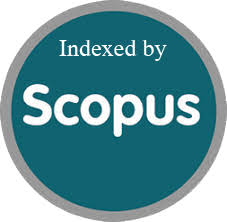The Disaggregation Model via Non-Parametric Approach
Abstract
Flow disaggregation models, which are one of the stochastic generation techniques, play a crucial role in the planning, design, and operation of water resource management systems and related projects. One distinguishing feature of these models is their ability to address the issue of missing observed data and compensate for it. They also enable the rescaling of data from a higher temporal level to a lower temporal scale. Data at lower temporal scales are typically required to address hydraulic and operational design problems in water resource projects. There are two main approaches to disaggregation flow data: the parametric approach and the non-parametric approach.One of the advantages of the disaggregation model is its ability to distribute flow data values from a key station to several sub-stations, both temporally and/or spatially, while preserving the basic statistical properties of the time series obtained from the model (mean, standard deviation, minimum, maximum, and correlation coefficient) for the observed data.In the current study, a non-parametric approach was used for the purpose of disaggregation approach. It is assumed that there is aggregated discharge data at a key station, and this data will be disaggregated into a corresponding series of discharges temporally and spatially at sub-stations that are statistically similar, using the SAMS 2010 platform program (Stochastic Analysis, Modeling, and Simulation). Annual and monthly discharge data for five stations measuring discharges on the Tigris River System in Iraq were used, including the Mosul Dam station on the Tigris River, the Asmawah station on the Khazir River, the Askiklik station on the Upper Zab, the Dibs Dam station on the Lower Zab, and the Baiji station on the Tigris River, covering a time span of twenty-three years. The statistical results of the disaggregation approach were compared with their observed counterparts and showed good agreement in most years and months and for all stations. Based on this, the method is recommended disaggregation of the data when decisions required water management strategies in these regions.
References
- A. Acharya, T.C. Piechota, H. Stephen, "Modeled streamflow response under cloud seedine in the North Platte River watershed", Journal of Hydrologic Engineering, Vol. 409, Issue:1-2, pp.305-314, 2011.
- B. Rajagopalan, Salas, J. D.Salas, and U. Lall, "Stochastic methods for modeling precipitation and streamflow", Advances in data-based approaches for hydrologic modeling and forecasting , pp. 1752, 2010.
- C.Bracken, B. Rajagopalan, and J. Prairie, "A Multisite Seasonal Ensemble Streamflow Forecasting Technique", Journal of Water Resource Research, Vol.46, pp. 1-12,2009. doi: 10.1029/2009WR007965.
- D. Koutsoyiannis, and A. Manetas, "Simple disaggregation by accurate adjusting procedures", Water Resource Research, Vol.32, pp. 2105 2117, 1996.
- D.N.Kumar, U. Lall, and M.R. Petersen,"Multisite disaggregation of monthly to daily streamflow", Water Resources Research,Vol.36 Issue:7, pp.18231833.2000. doi: 10.1029/2000WR900049.
- F.A.Filho, and U. Lall," Seasonal to interannual ensemble streamflow forecasts for Ceara, Brazil: Applications of a mutlivariate, semiparametric algorithm", Water Resource Research, Vol.39, Issue: 11, pp.1-11,2003. doi: 10.1029 /WR001373.
- G. Castellanos-Osorio , A. Lpez-Ballesteros , J. Prez- Snchez , and J. Senent," Disaggregated monthly SWAT+ model versus daily SWAT+ model for estimating environmental flows in Peninsular Spain", Journal of Hydrology, Vol.623, August 2023. doi.org/ 10.1016 /j.jhydrol.2023.129837.
- H. Bolouki, and M. Fazeli, "Evaluation of Multivariate Rainfall Disaggregation Performance Using MuDRain Model (Case Study: North East of Hormozgan Province", A mirkabir Journal of Civil Engineering, Vol.54 (12), pp.46574676, 2023. doi: 10.1029/96WR00488.
- H. Khalid Hameed, K. Ahmed Abdullah ,and R.Hoobi Irzooki, "Seepage Simulation of the Proposed Makhool Dam in North Iraq", Iraqi Journal of Science, Vol. 64,Issue:6, pp.2934-2945,2023.
- J. Prairie, B. Rajagopalan, U. Lall, and T. Fulp, "A stochastic nonparametric technique for spacetime disaggregation of streamflows",Water Resources Research, Vol.43, Issue:3,2007. doi: 10.1029/2005WR004721.
- J. R. Prairie, B. Rajagopalan, T. J. Fulp, E. A. Zagona, "Statistical nonparametric model for natural salt estimation", Journal of Environmental Engineering, Vol.131, Issue:1, pp.130138, 2005. doi: 10.1061/(asce)0733-9372(2005)131(1)130-138
- K. Grantz, B. Rajagopalan, M. Clark, and E. Zagona " A technique for incorporating largescale climate information in basinscale ensemble streamflow forecasts" Water Resources Research ,Vol. 41,Issue:10, 2005. doi: 10.1029/WR003467.
- K.Nowak, J. Prairie, and B. Rajagopalan, "Development of stochastic flow sequences based on observed data", Washington, DC: Allen Institute.2008.
- M. Velpuri, G. Titas,and U. N.V. , " A Multi criteria Decision Making based nonparametric method of fragments to disaggregate daily precipitation", Journal of Hydrology, Vol. 617, Part A, 2023. doi: 10.24996/ijs.2023.64.6.22.
- N. arlak, and . Tirek, " Noktasal Takn Frekans Fanalizi: Gksu Nehri ve Kayraktepe Baraj Vaka Analizi", Journal of the Faculty of Engineering and Architecture of Gazi University, Vol.31, Issue: 4, pp.1095-1103, 2016. doi: 10.17341/gummfd.79436.
- O.G.B.Sveinsson , T.S. Lee, J. D. Salas, W. L. Lane, D. K. Frevert, and T.B.M.J. Ouarda," Stochastic Analysis, Modeling, and Simulation (SAMS) Version 2010 ".USER's MANUAL, Colorado State University, March 2011. doi: 10.1016/j.jhydrol.2011.08.027.
- R. Younus Ahmad Hassan, A. Mohammad Younes, "Prediction of Daily Flow to the Great Zab River Using Artificial NeuralNetwork Models", Al-Rafidain Engineering Journal (AREJ) , Vol.28, Issue:.2, pp. 163-172,2023.
- S. Hazim Dawood, "Meteorological Estimations for selected stations in the North of Iraq", Al-Rafidain Engineering Journal (AREJ), Vol.17, Issue:1, 2009.
- S.H.AL-Zakar, N. arlak, O.M. Mahmood, "Disaggregation of Annual to Monthly Streamflow: A Case Study of Kzlrmak Basin (Turkey)", Advances in Meteorology, Vol.2017, 16 p, 2017. doi: 10.9790/4861-0901023443.
- S.K. Regonda, B. Rajagopalan, M. Clark, and E. Zagona, "A multimodel ensemble forecast framework: Application to spring seasonal flows in the Gunnison River Basin", Water Resources Research, Vol.42,Issue:9, 2006. doi: 10.1029/2005WR004653.
- T. Lee, and T. Ouarda, "Randomized block nonparametric temporal disaggregation of hydrological variables RB-NPD (version1.0) model development" Geoscientific Model Development Discussion, 2023. doi.org/10.5194/gmd-2022-274,2023.
- T. Lee, J. D.Salas, J. Prairie, "An enhanced nonparametric streamflow disaggregation model with genetic algorithm", Water Resource Research, Vol.46, 14 p, 2010. doi: 10.1029/2009WR007761.
- T. Lee, J.D. Salas, J. Keedy, D. Frevert, and T. Fulp, "Stochastic Modeling and Simulation of the Colorado River Flows", World Environmental and Water Resources Congress, 10 p.2007. doi: 10.1061/40927(243)423.
- U. Lall, and A. Sharma, " A nearest neighbor bootstrap for resampling hydrologic time series", Water Resources Research, Vol.32, Issue: 3, pp.679693, 1996. doi: 10.1029/95WR02966.
- U.Lall, "Recent advances in nonparametric function estimation: Hydrologic applications", Reviews of Geophysics, Vol.33, Issue:2, pp.10931102,1995. doi: 10.1029/95RG00343.
- V.V. Srinivas, and K. Srinivasan, "Hybrid moving block bootstrap for stochastic simulation of multi-site multi-season streamflows" Journal of Hydrology, Vol.302,Issue: 1, pp.307330,2005. doi: 10.1016/j.jhydrol.2006.01.023.
- Y. I. Moon, and U. Lall, (1994) "A kernel quantite function estimator for flood frequency analysis", Water Resources Research, Vol.30, Issue :11, pp.3095-3103, 1994. doi: 10.1029/94WR01217.








